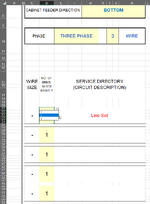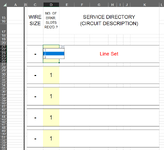Ok, I have wrote a section of code that is fairly long and includes many different cells. My question is this: Can I use the VBA code that I have written and push that code to another cell? I do not just want to simply copy and paste the logic into a cell, but I want the logic to be changed to look a the cells and reformat all the cells to match the new location.
So here is part of my VBA code below. It basically consist of cell D21 with a dropdown selection of 1,2, or 3. It merges and changes cells based on the selection made in the dropdown. However, I want to move the "logic" part of it to D28. Doing this the "old fashion" way, I would have to go through the entire code and change each cell to it's apporiate new location. This is EXTREMELY time consuming and leads to alot of error. There HAS to be an easier way to achieve this. D28 also has the exact dropdown as D21. I want the code to change based on the new location. So this is why a simple copy and paste will not work. Can this be done or am I dreaming? I can provide my entire code if necessary.
Private Sub HandleCase1()
' Merges and unmerges cells based on Case1 being selected
Range("C21:C26").merge
Range("C21").Value = "-"
Range("C21:C26").Borders(xlEdgeBottom).linestyle = xlContinuous
Range("C28:C33").merge
Range("C28").Value = "-"
Range("C28:C33").Borders(xlEdgeTop).linestyle = xlContinuous
Range("C28:C33").Borders(xlEdgeBottom).linestyle = xlContinuous
Range("C35:C40").merge
Range("C35").Value = "-"
Range("C35:C40").Borders(xlEdgeTop).linestyle = xlContinuous
Range("D21:D33").UnMerge
Range("D21:D26").merge
Range("D27").Interior.ColorIndex = xlNone
Range("D21:D26").Borders(xlEdgeBottom).linestyle = xlContinuous
Range("D28:D33").Borders(xlEdgeTop).linestyle = xlContinuous
Range("D28:D33").merge
If Range("D28").Value = "" Then Range("D28").Value = 1
Range("D34").Interior.ColorIndex = xlNone
Range("D35:D40").merge
Range("D28:D33").Borders(xlEdgeBottom).linestyle = xlContinuous
Range("D28:D33").Borders(xlEdgeTop).linestyle = xlContinuous
Range("D35:D40").Borders(xlEdgeTop).linestyle = xlContinuous
If Range("D35").Value = "" Then Range("D35").Value = 1
So here is part of my VBA code below. It basically consist of cell D21 with a dropdown selection of 1,2, or 3. It merges and changes cells based on the selection made in the dropdown. However, I want to move the "logic" part of it to D28. Doing this the "old fashion" way, I would have to go through the entire code and change each cell to it's apporiate new location. This is EXTREMELY time consuming and leads to alot of error. There HAS to be an easier way to achieve this. D28 also has the exact dropdown as D21. I want the code to change based on the new location. So this is why a simple copy and paste will not work. Can this be done or am I dreaming? I can provide my entire code if necessary.
Private Sub HandleCase1()
' Merges and unmerges cells based on Case1 being selected
Range("C21:C26").merge
Range("C21").Value = "-"
Range("C21:C26").Borders(xlEdgeBottom).linestyle = xlContinuous
Range("C28:C33").merge
Range("C28").Value = "-"
Range("C28:C33").Borders(xlEdgeTop).linestyle = xlContinuous
Range("C28:C33").Borders(xlEdgeBottom).linestyle = xlContinuous
Range("C35:C40").merge
Range("C35").Value = "-"
Range("C35:C40").Borders(xlEdgeTop).linestyle = xlContinuous
Range("D21:D33").UnMerge
Range("D21:D26").merge
Range("D27").Interior.ColorIndex = xlNone
Range("D21:D26").Borders(xlEdgeBottom).linestyle = xlContinuous
Range("D28:D33").Borders(xlEdgeTop).linestyle = xlContinuous
Range("D28:D33").merge
If Range("D28").Value = "" Then Range("D28").Value = 1
Range("D34").Interior.ColorIndex = xlNone
Range("D35:D40").merge
Range("D28:D33").Borders(xlEdgeBottom).linestyle = xlContinuous
Range("D28:D33").Borders(xlEdgeTop).linestyle = xlContinuous
Range("D35:D40").Borders(xlEdgeTop).linestyle = xlContinuous
If Range("D35").Value = "" Then Range("D35").Value = 1







